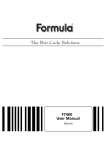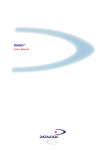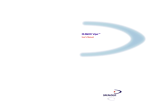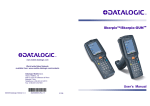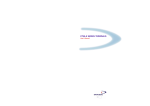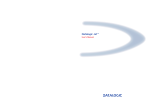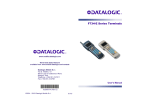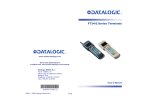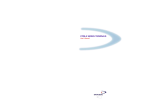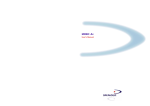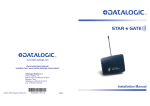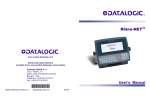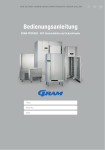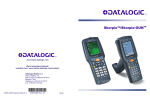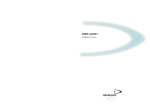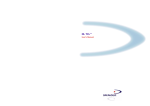Download Datalogic Formula User`s manual
Transcript
Formula Color™ User’s Manual FORMULA COLOR™ USER’S MANUAL DATALOGIC S.p.A. Via Candini 2 40012 – Lippo di Calderara di Reno Bologna – Italy Formula Color™ – User’s Manual Ed.: 03/2006 ALL RIGHTS RESERVED Datalogic reserves the right to make modifications and improvements without prior notification. Datalogic shall not be liable for technical or editorial errors or omissions contained herein, nor for incidental or consequential damages resulting from the use of this material. Product names mentioned herein are for identification purposes only and may be trademarks and or registered trademarks of their respective companies. © Datalogic S.p.A. 2004 - 2006 822000461 (Rev. B) CONTENTS REFERENCES ............................................................................................. v Conventions .................................................................................................. v Reference Documentation ............................................................................ v Services and Support.................................................................................... v SAFETY REGULATIONS............................................................................ vi General Safety Rules ....................................................................................vi Laser Safety.................................................................................................vii Radio Compliance......................................................................................... x Information for the User ................................................................................xi FCC Compliance..........................................................................................xii WEEE Compliance ......................................................................................xii GENERAL VIEW ....................................................................................... xiii QUICK START .......................................................................................... xiv 1 1.1 1.2 1.3 INTRODUCTION .......................................................................................... 1 Formula Color™ Terminal Description.......................................................... 1 Package Contents......................................................................................... 2 Accessories................................................................................................... 3 2 2.1 2.1.1 2.1.2 2.2 2.2.1 2.2.2 2.3 CONNECTIONS ........................................................................................... 4 Cradles ......................................................................................................... 4 F-Color Single Cradle ................................................................................... 4 F-Color Vehicle Cradle.................................................................................. 6 Connection to the Host Computer................................................................. 8 RS232 Connection via Cradle....................................................................... 8 RF Connection .............................................................................................. 9 Connection Cables...................................................................................... 10 3 3.1 3.2 3.3 3.4 3.5 3.6 3.6.1 3.6.2 3.6.3 3.6.4 3.6.5 BIOS SETUP MENU................................................................................... 11 General Information .................................................................................... 11 Activating the Setup Procedure................................................................... 11 Password .................................................................................................... 12 The Setup Menu and Its Configurable Items............................................... 12 Changing the Values of the Menu Items ..................................................... 13 Structure of the Formula Color™ Setup Pages........................................... 13 Console....................................................................................................... 14 Status Bar ................................................................................................... 15 Indications................................................................................................... 16 Devices ....................................................................................................... 17 PMU Config................................................................................................. 18 iii 3.6.6 3.7 Activities...................................................................................................... 19 Exit from the Setup Procedure .................................................................... 20 4 4.1 4.2 4.3 4.4 USE AND FUNCTIONING .......................................................................... 21 Terminal Startup ......................................................................................... 21 Barcode Scanning....................................................................................... 22 Description of the Keys ............................................................................... 23 File Transfer................................................................................................ 26 5 5.1 5.2 5.3 MAINTENANCE ......................................................................................... 27 Charging the Batteries ................................................................................ 27 Replacing the Batteries ............................................................................... 27 Cleaning the Terminal................................................................................. 29 6 TROUBLESHOOTING ............................................................................... 30 7 7.1 7.2 7.3 TECHNICAL FEATURES ........................................................................... 34 Formula Color™ Technical Features .......................................................... 34 F-Color Single Cradle Technical Features .................................................. 36 Reading Diagram ........................................................................................ 37 8 TEST CODES ............................................................................................. 38 GLOSSARY................................................................................................ 41 INDEX ......................................................................................................... 44 iv REFERENCES CONVENTIONS This manual uses the following conventions: "User" refers to anyone using a Formula Color™ terminal. "Terminal" refers to the Formula Color™ terminal. "You" refers to the System Administrator or Technical Support person using this manual to install, configure, operate, maintain or troubleshoot a Formula Color™ terminal. REFERENCE DOCUMENTATION For further information regarding Formula Color™ configuration, please refer to the following users' manuals: - DL DTP User's Manual - TDTPClient Reference Manual - DS for Formula DOS Development System Manual SERVICES AND SUPPORT Datalogic provides several services as well as technical support through its website. Log on to www.datalogic.com and click on the links indicated for further information including: • PRODUCTS Search through the links to arrive at your product page where you can download specific Manuals and Software & Utilities. • SERVICES & SUPPORT - Datalogic Services - Warranty Extensions and Maintenance Agreements - Authorised Repair Centres • CONTACT US E-mail form and listing of Datalogic Subsidiaries v SAFETY REGULATIONS NOTE Read this manual carefully before performing any type of connection to the Formula Color™ terminal. The user is responsible for any damages caused by incorrect use of the equipment or by inobservance of the indication supplied in this manual. GENERAL SAFETY RULES Use only the components supplied by the manufacturer for the specific Formula Color™ terminal being used. The use of cradles other than those supplied with the Formula Color™ terminal or indicated in the list in par. 1.3 could cause serious damage to the Formula Color™ terminal. Do not attempt to disassemble the Formula Color™ terminal, as it does not contain parts that can be repaired by the user. Any tampering will invalidate the warranty. When replacing the batteries or at the end of the operative life of the Formula Color™ terminal, disposal must be performed in compliance with the laws in force. Do not submerge the terminal in liquid products. vi LASER SAFETY The laser light is visible to the human eye and is emitted from the window indicated in the figure. Laser beam output window This product complies with 21 CFR Subchapter J AVOID EXPOSURE LASER LIGHT IS EMITTED FROM THIS APERTURE LASER LIGHT - DO NOT STARE INTO BEAM CLASS 2 LASER PRODUCT MAX. OUTPUT RADIATION 1.4 mW EMITTED WAVE LENGTH 630~680 nm EN60825-1:2001 CAUTION - CLASS 2 LASER LIGHT WHEN OPEN - DO NOT STARE INTO BEAM Figure 1 – Formula Color™ Laser Safety and Data Label D F E La luce laser è visibile all'occhio umano e viene emessa dalla finestra indicata nella figura. I Die Laserstrahlung ist für das menschliche Auge sichtbar und wird am Strahlaustrittsfenster ausgesendet (siehe Bild). Le rayon laser est visible à l'oeil nu et il est émis par la fenêtre désignée sur l'illustration dans la figure. La luz láser es visible al ojo humano y es emitida por la ventana indicada en la figura. LUCE LASER NON FISSARE IL FASCIO APPARECCHIO LASER DI CLASSE 2 MINIMA POTENZA DI USCITA: LUNGHEZZA D'ONDA EMESSA: CONFORME A EN 60825-1 (2001). LASERSTRAHLUNG NICHT IN DER STRAHL BLINKEN PRODUKT DER LASERKLASSE 2 MAXIMALE AUSGANGLEISTUNG: WELLENLÄNGE: ENTSPR. EN 60825-1 (2001). RAYON LASER EVITER DE REGARDER LE RAYON APPAREIL LASER DE CLASSE 2 PUISSANCE DE SORTIE: LONGUER D'ONDE EMISE: CONFORME A EN 60825-1 (2001). RAYO LÁSER NO MIRAR FIJO EL RAYO APARATO LÁSER DE CLASE 2 MÁXIMA POTENCIA DE SALIDA: LONGITUD DE ONDA EMITIDA: CONFORME A EN 60825-1 (2001). vii ENGLISH The following information is provided to comply with the rules imposed by international authorities and refers to the correct use of your terminal. STANDARD LASER SAFETY REGULATIONS This product conforms to the applicable requirements of both CDRH 21 CFR 1040 and EN 60825-1 at the date of manufacture. For installation, use and maintenance, it is not necessary to open the device. WARNING Use of controls or adjustments or performance of procedures other than those specified herein may result in exposure to hazardous visible laser light. The product utilizes a low-power laser diode. Although staring directly at the laser beam momentarily causes no known biological damage, avoid staring at the beam as one would with any very strong light source, such as the sun. Avoid that the laser beam hits the eye of an observer, even through reflective surfaces such as mirrors, etc. ITALIANO Le seguenti informazioni vengono fornite dietro direttive delle autorità internazionali e si riferiscono all’uso corretto del terminale. NORMATIVE STANDARD PER LA SICUREZZA LASER Questo prodotto risulta conforme alle normative vigenti sulla sicurezza laser alla data di produzione: CDRH 21 CFR 1040 e EN 60825-1. Non si rende mai necessario aprire l’apparecchio per motivi di installazione, utilizzo o manutenzione. ATTENZIONE L'utilizzo di procedure o regolazioni differenti da quelle descritte nella documentazione può provocare un'esposizione pericolosa a luce laser visibile. Il prodotto utilizza un diodo laser a bassa potenza. Sebbene non siano noti danni riportati dall’occhio umano in seguito ad una esposizione di breve durata, evitare di fissare il raggio laser così come si eviterebbe qualsiasi altra sorgente di luminosità intensa, ad esempio il sole. Evitare inoltre di dirigere il raggio laser negli occhi di un osservatore, anche attraverso superfici riflettenti come gli specchi. viii DEUTSCH Die folgenden Informationen stimmen mit den Sicherheitshinweisen überein, die von internationalen Behörden auferlegt wurden, und sie beziehen sich auf den korrekten Gebrauch vom Terminal. NORM FÜR DIE LASERSICHERHEIT Dies Produkt entspricht am Tag der Herstellung den gültigen EN 60825-1 und CDRH 21 CFR 1040 Normen für die Lasersicherheit. Es ist nicht notwendig, das Gerät wegen Betrieb oder Installations-, und Wartungsarbeiten zu öffnen. ACHTUNG Jegliche Änderungen am Gerät sowie Vorgehensweisen, die nicht in dieser Betriebsanleitung beschrieben werden, können ein gefährliches Laserlicht verursachen. Der Produkt benutzt eine Laserdiode. Obwohl zur Zeit keine Augenschäden von kurzen Einstrahlungen bekannt sind, sollten Sie es vermeiden für längere Zeit in den Laserstrahl zu schauen, genauso wenig wie in starke Lichtquellen (z.B. die Sonne). Vermeiden Sie es, den Laserstrahl weder gegen die Augen eines Beobachters, noch gegen reflektierende Oberflächen zu richten. FRANÇAIS Les informations suivantes sont fournies selon les règles fixées par les autorités internationales et se réfèrent à une correcte utilisation du terminal. NORMES DE SECURITE LASER Ce produit est conforme aux normes de sécurité laser en vigueur à sa date de fabrication: CDRH 21 CFR 1040 et EN 60825-1. Il n’est pas nécessaire d’ouvrir l’appareil pour l’installation, l’utilisation ou l’entretien. ATTENTION L'utilisation de procédures ou réglages différents de ceux donnés ici peut entraîner une dangereuse exposition à lumière laser visible. Le produit utilise une diode laser. Aucun dommage aux yeux humains n’a été constaté à la suite d’une exposition au rayon laser. Eviter de regarder fixement le rayon, comme toute autre source lumineuse intense telle que le soleil. Eviter aussi de diriger le rayon vers les yeux d’un observateur, même à travers des surfaces réfléchissantes (miroirs, par exemple). ix ESPAÑOL Las informaciones siguientes son presentadas en conformidad con las disposiciones de las autoridades internacionales y se refieren al uso correcto del terminal. NORMATIVAS ESTÁNDAR PARA LA SEGURIDAD LÁSER Este aparato resulta conforme a las normativas vigentes de seguridad láser a la fecha de producción: CDRH 21 CFR 1040 y EN 60825-1. No es necesario abrir el aparato para la instalación, la utilización o la manutención. ATENCIÓN La utilización de procedimientos o regulaciones diferentes de aquellas describidas en la documentción puede causar una exposición peligrosa a la luz láser visible. El aparato utiliza un diodo láser a baja potencia. No son notorios daños a los ojos humanos a consecuencia de una exposición de corta duración. Eviten de mirar fijo el rayo láser así como evitarían cualquiera otra fuente de luminosidad intensa, por ejemplo el sol. Además, eviten de dirigir el rayo láser hacia los ojos de un observador, también a través de superficies reflectantes como los espejos. RADIO COMPLIANCE In radio systems configured with portable terminals and access points, the frequencies to be used must be allowed by the spectrum authorities of the specific country in which the installation takes place. Be absolutely sure that the system frequencies are correctly set to be compliant with the spectrum requirements of the country. The Radio Card used in this product automatically adapts to the frequencies set by the system and does not require any parameter settings. x Information for the User ENGLISH Contact the competent authority responsible for the management of radio frequency devices of your country to verify the eventual necessity of a user license. Refer to the web site http://europa.eu.int/comm/enterprise/rtte/spectr.htm for further information. ITALIANO Prendi contatto con l'autorità competente per la gestione degli apparati a radio frequenza del tuo paese, per verificarne l'eventuale necessità della licenza d'uso. Inoltre puoi trovare ulteriori informazioni al sito: http://europa.eu.int/comm/enterprise/rtte/spectr.htm. FRANÇAIS Contactez l'autorité compétente en la gestion des appareils à radio fréquence de votre pays pour vérifier la nécessité du permis d'usage. Pour tout renseignement vous pouvez vous adresser au site web: http://europa.eu.int/comm/enterprise/rtte/spectr.htm. DEUTSCH Um die Notwendigkeit der Verwendungslizenz zu prüfen, wenden Sie sich an die Behörde, die auf der Radiofrequenzgerätsführung Ihres Lands bewandert ist. Weitere Informationen sind verfügbar auf dem Web Site: http://europa.eu.int/comm/enterprise/rtte/spectr.htm. ESPAÑOL Contacta con la autoridad competente para la gestión de los dispositivos de radio frecuencia de tu país, para verificar si es necesario la licencia de uso. Además se puede encontrar mas información en el sitio web: http://europa.eu.int/comm/enterprise/rtte/spectr.htm. xi FCC COMPLIANCE The following compliance refers only to the Formula Color™ batch model. Modifications or changes to this equipment without the expressed written approval of Datalogic could void the authority to use this equipment. This device complies with PART 15 of the FCC Rules. Operation is subject to the following two conditions: (1) This device may not cause harmful interference, and (2) this device must accept any interference received, including interference which may cause undesired operation. This equipment has been tested and found to comply with the limits for a Class A digital device, pursuant to part 15 of the FCC Rules. These limits are designed to provide reasonable protection against harmful interference when the equipment is operated in a commercial environment. This equipment generates, uses, and can radiate radio frequency energy and, if not installed and used in accordance with the instruction manual, may cause harmful interference to radio communications. Operation of this equipment in a residential area is likely to cause harmful interference in which case the user will be required to correct the interference at his own expense. WEEE COMPLIANCE xii GENERAL VIEW FORMULA COLOR™ A B C F E D Figure 2 – Formula Color™ Terminal Overview Key: A) B) C) D) E) F) Good Read / Battery Status / Programmable LED Laser beam output window Scan key Battery charge and RS232 serial contacts IrDA Port Navigation key xiii QUICK START Verify that the Formula Color™ and all the parts supplied with the equipment are present and intact when opening the packaging. Contact the nearest Datalogic distributor for further information. Keep this package should it be necessary for shipping to technical assistance centre. Formula Color™ All Models When using the Formula Color™ terminal for the first time: 1) 2) 3) 4) 5) xiv remove the battery pack and the Formula Color™ terminal from the packaging; charge the battery pack by either: a) correctly inserting the battery pack into the Formula Color™ terminal (refer to par. 5.2 in this manual) and positioning it into the Formula Color™ single cradle. The cradle must be powered through the FPS18 power supply (refer to par. 2.1 and 5.1 in this manual and the Formula Color™ single cradle manual for further details); b) inserting the battery pack directly into the MBC8600 multi-slot battery charger. The battery charger must be powered through the FPS18 power supply (refer to the MBC8600 manual for further details). Then, insert the charged battery pack into the terminal (refer to par. 5.2 in this manual); as soon as the charged battery is inserted into the terminal, the boot sequence is run until the start up menu is displayed on the terminal. Then, the terminal is ready. There are two different flash disks. Disk C: allows both reading and writing, while Disk A: is read-only and contains the operating system and general files including some tools. After the boot sequence the keyboard is in “numeric mode” allowing to type the numbers when pressing the keys (see par. 4.3). For typing letters and special characters first press the “alpha” white key. Press it again to exit this mode and re-enter “numeric mode”. configure the BIOS parameters keeping in mind that their management may influence the battery duration (refer to chapter 3 in this manual); once the system prompt (C:\>) is displayed, it is possible to run all DOS commands. At first start-up it is suggested to configure the system date and time through the “date” and “time” DOS commands. The “dir” command allows displaying a list of the files that are in the current directory, while the “cd” command allows changing the current directory. For further details about the DOS operating system refer to the documentation provided within the CD-ROM included in the packaging; 6) for transferring files between the terminal (Disk A: is read-only) and a PC it is necessary to run the serial communication server based on the Datalogic DTPS protocol by typing ds.bat and pressing the [Enter] key to activate the communication server. For correct communication with the terminal, it is necessary that a client application program based on the DTP protocol is running on PC side. The CD-ROM provided within the packaging contains the WinDTP and DL Mobile Configurator™ tools which allow managing and configuring the terminal and its C: Disk. In particular, WinDTP is a software package managing the terminal disk and its files, while DL Mobile Configurator™ allows installing and configuring DL TCL™. Be careful that both the Server and Client serial communication parameters share the same value. Default parameters are: baud rate = 115000, parity = none, stop bit = 1, data bits = 8. The Formula Color™ batch model is now ready to be loaded with the software application program. Formula Color™ Radio Models Only This terminal contains an 802.11b radio module. The net.cfg file, containing radio configuration parameters, and the socket.cfg file, containing the TCP/IP protocol configuration parameters, are already installed on Disk C:. When using the Formula Color™ Wi-Fi terminal for the first time: 1) 7) repeat the procedure given for all Formula Color™ models from step 1 to step 6; edit the net.cfg file available in the C:\RF directory to configure the radio parameters: The most significant parameters are listed below: ESS_ID Encrypt_Enable Encrypt_Key_Index Encrypt_Key1 Encrypt_Key2 Encrypt_Key3 Encrypt_Key4 ESS_ID configures the Server Set Identifier (Network Name); while the other parameters enable WEP. xv The terminal can communicate with an access point sharing the same parameter values. By default WEP is not activated, default values of the net.cfg parameters are: ESS_ID tsunami Encrypt_Enable N Encrypt_Key_Index 1 Encrypt_Key1 11 11 11 11 11 11 11 11 11 11 11 11 11 Encrypt_Key2 22 22 22 22 22 22 22 22 22 22 22 22 22 Encrypt_Key3 33 33 33 33 33 33 33 33 33 33 33 33 33 Encrypt_Key4 44 44 44 44 44 44 44 44 44 44 44 44 44 8) edit the socket.cfg file to configure the TCP/IP protocol: The most significant parameters are listed below: IP address route add default if0 domain server IP address is the terminal IP address, route add default if0 configures the default Gateway, while domain server configures the DNS. By default IP address = 0.0.0.1 which indicates that the DHCP server is enabled. For further details consult the LAN administrator or qualified personnel. The Formula Color™ radio models are now ready to be loaded with the software application program. xvi INTRODUCTION 1 1.1 1 INTRODUCTION FORMULA COLOR™ TERMINAL DESCRIPTION The Formula Color™ professional mobile computer has been designed to satisfy a wide range of data collection tasks in retail, light industrial, and health care environments. Formula Color™ offers operators compact-sized ergonomics combined with a very intuitive user interface, which includes the “green spot” (Datalogic patent application), providing “good read” feedback directly on the code, where the user usually tends to be looking. Furthermore, the large, bright, easy-to-read color display is ideal for indoor/outdoor use and helps users work more efficiently, while the practical 30-key “mobile phonelike” keypad allows data, codes and descriptions to be input very quickly. The best performance in barcode data capture is granted by Formula Color’s™ miniature scanning engine, providing a very bright laser beam and great reading results on any kind of code or surface. In addition, to support long-term scanintensive warehousing operations, Formula Color™ takes advantage of a removable/rechargeable Li-ION high power battery pack. Fast data computing is performed by the powerful hardware platform, based on PC technology, supported by the oversized standard memory: 8 MB Ram + 8 MB Flash that can be upgraded to 512 MB through a standard compact flash memory card. The integrated Wi-Fi card for Wireless standard IEEE802.11b communication, allows Formula Color™ to access any Wi-Fi compliant WLAN infrastructure and be immediately on line with any WMS through DL-TCL, Datalogic’s terminal emulator software that supports both VT100/220 and IBM5250 standards. Formula Color™ also offers a large selection of peripherals and accessories. It is compatible with most of Datalogic’s software tools, such as DL Mobile Configurator™, DL Keep Connecting™, DL TN Link™, DL Web-Link™ and MCL Collection™ Suite for programming, monitoring and configuration operations. 1 FORMULA COLOR™ 1 1.2 PACKAGE CONTENTS The Formula Color™ terminal package contains: Formula Color™ terminal; Li-Ion rechargeable battery pack; Belt clip; User’s manual; CD-ROM containing the DS for Formula DOS Development System, Datalight ROM-DOS 7.0, and Utility program software and relative documentation; Any other packages will contain the accessories necessary for the Formula Color™ terminal connection to the host computer and to the network: the cradle, power supply, and one or more connection cables. Remove all the components from their packaging, check their integrity and congruity with the packing documents. CAUTION NOTE 2 Keep the original packaging for use when sending products to the technical assistance center. Damage caused by improper packaging is not covered under the warranty. Rechargeable battery packs are not initially charged. Therefore the first operation to perform is to charge them in the appropriate cradle. See paragraph 5.1. INTRODUCTION 1.3 1 ACCESSORIES Cradle 94A151092 F-Color Single Cradle (RS232). 94A151094 F-Color Vehicle Cradle (RS232). 94A151095 F-Color Modem Cradle (RS232). 94A151091 F-Color Multiple Cradle (RS232, 4 slots). Charger 94A151030 MBC8600 Multi-Battery Charger. Batteries 94ACC1290 F-Color Li-Ion Battery Pack. 94ACC1284 F-Color Alkaline Battery Pack. Software DL TCL™ and DL Mobile Configurator™, the Datalogic Terminal Emulation Client (DL TCL) providing VT100, VT220 and IBM5250 Telnet terminal emulation and the Datalogic terminal configuration utility. DL Mobile Configurator™ Enterprise, the Datalogic Windows-based utility tool allowing to configure and monitor a radio frequency network terminal with DL TCL™ Terminal Emulation. DL Keep Connecting™, the Datalogic middleware software designed to monitor, manage, route and maintain the terminal network installation, ensuring connection and operability. Case 94ACC1285 Formula Color™ Functional Case 3 FORMULA COLOR™ 2 3 2 CONNECTIONS 2.1 2.1.1 CRADLES F-Color Single Cradle With the Formula Color™ terminal, both the standard F-Color single cradle and the vehicle version can be used. A C B D E Figure 3 – F-Color Single Cradle Overview Key: A) Formula Color™ terminal battery recharge contacts B) Power indicator LED C) Connector for host computer connection (RS232) D) Power supply connector E) Modem connector (F-Color modem cradle only) The F-Color single cradle is a battery charger and also functions as a serial communication interface between the host computer (RS232) and the RS232 interface on the Formula Color™ terminal. 4 CONNECTIONS 2 By inserting the Formula Color™ terminal into the cradle as shown in the figure, its batteries can be charged. Insert the terminal from the top of the cradle and push the terminal down until the cradle clip clicks. Figure 4 - Terminal Insertion To remove the terminal from the F-COLOR single cradle, simply pull it upwards while firmly holding down the cradle. Terminal Battery Status LED When the terminal is inserted into the cradle, the terminal LED signals the status of the its batteries: COLOR Green blinking Constant red Constant green Orange blinking Off STATUS Battery slow charging or waiting precharge timeout Battery fast charging Battery charged Battery failure Alkaline battery 5 FORMULA COLOR™ 2 3 2.1.2 F-Color Vehicle Cradle The F-Color vehicle cradle comes with its accessories already assembled. To install it inside a vehicle driving compartment, proceed as follows: 1) mount the metal bracket; 2) connect a regulated power supply between the vehicle’s battery and the F-Color single cradle. CAUTION Do not connect the cradle directly to the vehicle's battery. Possible voltage surges can damage the cradle or cause it to malfunction. Power Cable Specifications: The power supply cable must have the following characteristics: Min Current Capacity Male Plug 1A Polarity: Mechanical dimensions: Metal plug length: positive external negative internal external diameter: 5.5 mm internal diameter: 2.1 mm 14 mm Insert the Formula Color™ terminal only after mounting the cradle in the vehicle. Terminal Battery Status LED When the terminal is inserted into the cradle, the terminal LED signals the status of the its batteries: COLOR Green blinking Constant red Constant green Orange blinking Off 6 STATUS Battery slow charging or waiting precharge timeout Battery fast charging Battery charged Battery failure Alkaline battery CONNECTIONS 2 Figure 5 – Removing Formula Color™ from the F-Color Vehicle Cradle To remove the Formula Color™ terminal from the F-Color vehicle cradle, you must first press the plastic retaining clip shown in the figure and pull the Formula Color™ terminal upwards. 7 FORMULA COLOR™ 2 3 2.2 CONNECTION TO THE HOST COMPUTER Before continuing with this phase be sure both the computer and the F-Color cradle are turned off. CAUTION 2.2.1 RS232 Connection via Cradle To connect the F-Color single cradle to the host computer proceed as follows: 1 - Connect the cable to the serial port of the host computer; 2 - Connect the other end of the same cable (RJ connector) to the RS232 port of the cradle; 3 - Insert the power-supply plug into the connector on the base of the cradle; 4 - Attach the power supply to a power outlet; 5 - Turn on the computer; 6 - Put the Formula Color™ terminal into its cradle. A B C Figure 6 – RS232 Cradle Connection Key: A) Host Computer B) F-Color Single Cradle C) Power Supply 8 CONNECTIONS 2.2.2 2 RF Connection Formula Color™ Wi-Fi versions can communicate with the host using the on-board radio frequency module and an Access Point connected to the host computer. Figure 7 – RF Connection Key: A) Formula Color™ Wi-Fi Terminal B) Access Point 9 FORMULA COLOR™ 2 3 2.3 CONNECTION CABLES The following cables are available depending on the type of computer and connection. The cables and cable kits are listed with their order number. RS232 Cable with 9-pin Host Connector: 94A054000 Cradle side RJ45 1 TX Host/PC side 9-pin D-sub (female) 2 RTS 2 3 4 5 8 GND 5 CTS 7 RX 3 4 1 RS232 Cable with 25-pin Host Connector: 94A054010 Cradle side RJ45 1 TX RTS 2 3 4 5 Host/PC side 25-pin D-sub (female) 3 5 GND CTS RX 7 4 2 8 20 10 BIOS SETUP MENU 3 3.1 3 BIOS SETUP MENU GENERAL INFORMATION The Formula Color™ terminal is very versatile and can be adapted to suit many special requirements by configuring certain parameters which can be changed after the Formula Color™ terminal’s boot sequence. The activities of accessing the parameters and their modification are commonly referred to as Formula Color™ terminal setup activities. The parameters have their default values, which are loaded automatically during the booting sequence if the following conditions occur: the first time the Formula Color™ terminal is booted, as initial setup of the parameters themselves; if, during the boot sequence, the BIOS notes that the previously-set configuration parameters might not be complete or correct. 3.2 ACTIVATING THE SETUP PROCEDURE The BSETUP.EXE program is the only way to modify the Formula Color™ terminal parameters. It is a normal DOS program and can be invoked after the Formula Color™ terminal’s boot sequence. The application has the following two options: BSETUP –C the program checks the status of the CMOS. If the parameters are incorrect, it asks if you want to modify them. Otherwise the program exits. Default is no check; BSETUP -D with this option you can load the DEFAULT configuration. In the NEWAUTO.BAT file it is useful to invoke “BSETUP -C”, so that if for some reasons the CMOS RAM is corrupted the user is notified. The application does not provide a method to change date/time, since you can use the DOS commands DATE and TIME. 11 FORMULA COLOR™ 3 3.3 PASSWORD The password mechanism is used for protecting access to Formula Color™ terminal parameters. If BSETUP.EXE is run with the –C option, it will warn the user about an eventual CMOS corruption before asking for the password. No password is required to be warned about the CMOS memory. This protection applies only to the setup procedure, so the check option “BSETUP C” is not protected; this means that everybody can know the nature of loaded parameters (CMOS, EEPROM or factory configuration). The application recognizes two passwords which are case sensitive: A) user defined B) the string “degibkdr” If the user forgets the password, the fixed (B) password provides the key to access the setup procedure. If a wrong password is entered, the program ends returning to the DOS prompt. Notice that the password protects only the Formula Color™ terminal parameters, not the terminal itself. The password can be disabled by entering a null string. 3.4 THE SETUP MENU AND ITS CONFIGURABLE ITEMS The actual items present in the BSETUP menus may depend on the BSETUP.BIN file and the BIOS version. If the BSETUP.BIN does not match with the BIOS version, BSETUP.EXE will produce an error message. The setup menu is composed of several pages, every page contains a list of items and every item corresponds to a terminal parameter. There is also an exit page, that allows you to save or discard the modifications. Every page has its own title, written in the upper row of the screen. Every item has a title and a value (the current value). The title is written on the left, the value on the right. The current item is characterized by a dot between the title and the value. You can navigate through pages, move between items and modify them. You can recognize two types of parameters: valued and ranged. With the ranged parameters, you must enter a valid value. Erroneous values are recognized, and you must reenter a correct number. Erroneous values cannot be introduced with valued parameters because you can only select from the ones shown. 12 BIOS SETUP MENU 3.5 3 CHANGING THE VALUES OF THE MENU ITEMS To change the values of the menu items, you must use the Formula Color™ terminal keyboard. To change an item, first go to its page and then select it by moving the dot. To change the value of the items, you will have to use the keys indicated in the table below. KEY FUNCTION [ESC] Activates the exit page Right Arrow Next page Left Arrow Previous page Down Arrow Next item Up Arrow Previous item [SPACE][ENTER] Valued items: change value cycling through the valid ones [SPACE][ENTER] Ranged items: enter the modify mode [ENTER] Ranged items: leave the modify mode 3.6 STRUCTURE OF THE FORMULA COLOR™ SETUP PAGES The tables below describe the SETUP pages which are available as well as the SETUP items relating to each page. In the VALUES column, an asterisk or a value in parenthesis indicates the default value. 13 FORMULA COLOR™ 3 3.6.1 Console ITEM VALUES DESCRIPTION NOTE Scroll Software Track Virt Both (*) Scrolling mode See Scrolling Mode note below Contrast Ranged: 0..127 (65) LCD contrast See Contrast below Light always on (*) 5s, 10s, 15s, 30s, 1m, 2m, 3m, 5m, 10m, 15m, 30m Timeout for the backlight Intensity Low High (*) Enable (*) Disable Backlight intensity Kbd freq. Ranged: 1..100 (3) Keyboard click Frequency (100 Hz steps) Password String up to 8 characters Selection of the new Simply press password to enter [ENTER] to disable setup the password Kbd click note Keyboard click Scrolling Mode The Formula Color™ display adapter allows the application to write on a virtual 25 lines by 80 columns display. On the other hand, the user can see only a portion of this virtual display at a time, which we call the physical display. The "scroll" parameter controls which portion of the virtual display is seen by the user. The display can always be scrolled by the application program. Software: the physical display position is fixed. It can be moved only by the application program. Track: the physical display follows the cursor vertically only through BIOS. Virt: it is only possible to scroll the display by the keyboard. Both: Both the Virtual and Track mode are enabled. Contrast The CMOS value of LCD contrast represents the only parameter that can be modified outside the BSETUP.EXE application. As a matter of fact, selecting the contrast mode [FUNC]-[4] gives you the ability to change this value using the up and down arrows; this changing does not affect the EEPROM value. 14 BIOS SETUP MENU 3.6.2 3 Status Bar ITEMS VALUES DESCRIPTION NOTE Bar Visible (*) Hidden Shows the status bar. You can later hide / show the bar using keyboard Clock Enabled (*) Disabled Enables the clock icon on the status bar. Battery Enabled (*) Disabled Enables showing satus. Arrows Enabled (*) Disabled Enables the icon showing the current arrows function. Kb Status Enabled (*) Disabled Enables the icon showing the current keys function. Sel. Key Enabled (*) Disabled Enables the icon showing the currently selected letter when using the keyboard alpha mode. the icon the battery 15 FORMULA COLOR™ 3 3.6.3 Indications DESCRIPTION NOTE Battery warning ON (*) OFF ITEMS Enables / disables Low battery notification Cradle Ins / Ext ON (*) OFF Enables / disables Cradle insertion notification When battery notification is enabled, the terminal will signal when batteries are completely run down. 3 beeps will be heard and the red LED will start blinking. When cradle notification is enabled, the terminal will emit 1 beep on cradle insertion, and 2 beeps on cradle extraction. Charger Status ON (*) OFF Enables / disables battery status signaling when the terminal is inserted into the cradle. 16 VALUES BIOS SETUP MENU 3.6.4 3 Devices ITEM VALUES DESCRIPTION Com 1 Off Elect Elect+wu(*) Optical Selects type and use of COM 1. NOTES CF Sleep Off On (*) Wakeup Status of the card when the terminal is off. When in Wake-up, the card is powered and can wake the terminal in case of data reception. Keyboard On (*) Wakeup Enables / disables keyboard as a wakeup source RTC On Wakeup (*) Enables / disables the RTC alarm as a wakeup source. LCD sleep On Off (*) If on, keeps the display on when If LCD is on, it is the terminal goes into SUSPEND strongly mode recommended to also set the Keyboard to Wakeup Precharge None (*) 30 m, 60 m, 120 m, infinite Once the terminal is inserted into the cradle, the terminal waits the precharge timeout before it starts charging. 17 FORMULA COLOR™ 3 3.6.5 PMU Config ITEM VALUES DESCRIPTION Automatic On (*) Off Enables automatic power management High speed 8 MHz 16 MHz (*) 32 MHz 8 MHz 4 MHz 2 MHz 1 MHz (*) Clock frequency in ON state. See description of Power Management for further information Clock frequency in IDLE state High->low 1/8 s 1/4 s 1/2 s (*) 1s 4s 8s 16 s Selects the period without Primary activity (see Activities) before passing from High speed to the IDLE state (Low speed) Low->sleep 8s 16 s (*) 32 s 1m 4m 8m 16 m Selects the period without any activity before passing from the IDLE state (Low speed) to SUSPEND (Off). Sleep->off tout Disabled 1m 8m 16 m 32 m 1 h (*) 2h 4h Selects the period without any activity before passing from SUSPEND to OFF. Low speed 18 BIOS SETUP MENU 3 Automatic If the Automatic parameter is OFF, all other Power Management parameters have no meaning. When the Automatic parameter is ON, the Power Management proceeds as follows: − after the high-low timeout selected time the CPU automatically reduces its clock frequency and passes from High speed to Low speed (both frequencies can be set through setup); − once the CPU is in Low speed and no activity occurs after the programmed timeout it enters the SUSPEND state. The CPU resumes operations when a WAKEUP event occurs, or when the SCAN key is pressed; − when the CPU is in SUSPEND and no WAKEUP event occurs after the programmed time, it enters the OFF state through which all peripherals are disabled. The CPU resumes operation only when pressing the SCAN key. 3.6.6 Activities If the Power Management - Automatic parameter is selected OFF, all Activities parameters have no meaning. The primary activities cause the CPU to pass to High speed, while the secondary ones allow the CPU to stay in Low speed if it is already in this state (see par. 3.6.5). The value OFF indicates that activity on the device has no effect on the CPU. ITEM VALUES Com 1 Off Primary (*) Secondary CF Off (*) Primary Secondary Indicates the level of activity for the radio frequency module. LCD Off Primary (*) Secondary Off Primary (*) Secondary Off Primary (*) Secondary Indicates the level of activity for video operations (excluding cursor blink). Keyboard Disk DESCRIPTION Indicates the level of activity for the UART/IR interface. Indicates the level of activity for the keyboard. Indicates the level of activity for all accesses to flash disk (boot and nonboot). 19 FORMULA COLOR™ 3 3.7 EXIT FROM THE SETUP PROCEDURE To end the SETUP procedure, you will have to: 1 - Select the Exit menu by pressing [ESC] 2 - Select one of the items by pressing the correct key (an erroneous one re-enters the setup procedure): KEY DESCRIPTION Press [S] to activate Saves the new values in the CMOS the function. memory and EEPROM memory and exits. Press [C] to activate Saves the new values in the CMOS the function. memory and exits. Press [Q] to activate Discards the new values and exits. the function. Press [D] to activate Load the default factory values. the function. - - 20 ITEM CMOS+EEPROM Save & Exit CMOS Save & Exit Discard Factory parameters If you exit with saving, a message appears notifying that the program is about to quit, and you can choose to reboot the Formula Color™ terminal to see the effects of the new configuration. Remember that the Formula Color™ terminal parameters are used by BIOS at boot-time. If you exit with the “Discard” command, no change will affect CMOS and EEPROM memories. If you choose the “factory parameters”, the application applies it and then reenters the setup procedure. USE AND FUNCTIONING 4 4 USE AND FUNCTIONING The use of the Formula Color™ terminal is subordinate to the application software loaded. Once an application is loaded, barcode scanning can be performed by pressing the [SCAN] key. 4.1 TERMINAL STARTUP The Formula Color™ terminal turns on when the SCAN key is pressed. For batch models, the prompt is displayed or if present the application program starts. For radio models, the following popup window is briefly displayed while the radio connects with the base station: The terminal goes into low power consumption mode (display off), when it is no longer used for more than a programmable timeout (default 16 sec. - par. 3.6.5). In this mode it can be awakened (resuming operation) by external events such as SCAN key press, radio transmission, etc. see par. 3.6.4) To turn the terminal off, press FUNC + ESC key. 21 FORMULA COLOR™ 4 4.2 BARCODE SCANNING To scan barcodes, point the Formula Color™ terminal laser beam onto the code from within its readable range while pressing the [SCAN] key. See reading diagram in par. 7.3. The lighted band emitted by the laser must completely intercept the barcode as shown in the figure below. The terminal LED, the emission of an acoustic signal, and the green spot will indicate that the scan has taken place correctly. NO NO OK OK Figure 8 – Formula Color™ Terminal Scanning a Barcode NOTE 22 The heat that can be felt in the area of the battery pack is not a symptom of a malfunction; rather, it is a normal state due to the Formula Color™ terminal being in use. USE AND FUNCTIONING 4.3 4 DESCRIPTION OF THE KEYS The Formula Color™ terminal keyboard is made up of a total of 27 keys. Figure 9 – Formula Color™ Keyboard POWER AND DISPLAY CONTROL KEYS The [SCAN} key is used to turn ON the terminal and to activate the laser scanner for barcode reading. It is not possible to activate the laser scanner for barcode reading if the data collection software application program is not currently running on the terminal. Turns OFF the terminal. 23 FORMULA COLOR™ 4 Has 4 different functions depending on its current state. STATE FUNCTION HOW TO ENTER THE STATE Normal Acts as the PC arrows keys. (The keys are interpreted by the It is the default state. application). Scroll mode Moves the physical screen window FUNC-2 toggles the on the logical screen. state. Contrast adjustment The UP / DOWN arrows can be FUNC-4 toggles the used to adjust the contrast. state. Volume adjustment The UP / DOWN arrows can be FUNC-5 toggles the used to adjust the volume of the state. beeper. The keyboard status can be displayed on the status bar if the keyboard status icon has been enabled in the bsetup program. To show / hide the status bar, press FUNC-3. If the contrast is set too low (very faint), you will not be able to determine when the terminal is off. NOTE [ENTER]: corresponds to the [ENTER] key on a PC. 24 USE AND FUNCTIONING 4 ALPHANUMERIC KEYS C B A D A) Function of the key in Normal mode; B) Function of the key in FUNC mode; C) Function of the key in SHIFT mode; D) Function of the key in ALPHA mode; When in ALPHA mode, press the key until the desired letter is displayed. The letter is entered if you wait a short timeout or if you press a different key. To show on the status bar the current keyboard mode (FUNC, ALPHA, SHIFT, NORMAL) and / or the currently selected alpha symbol, enable the appropriate icons in bsetup. ALPHA MODE Switches keyboard from the alphabetical ALPHA mode to the number and symbol NORMAL mode. The keyboard remains in this mode till the ALPHA key is pressed again. FUNC MODE Switches keyboard to the FUNC mode from the ALPHA or NORMAL mode. The FUNC key press preceding any keyboard key enables the character / function in green positioned above the key. The keyboard remains in this mode until the next general key is pressed, then it returns to the previous mode. For example, to select the [ : ] character, press [FUNC]-[0] in sequence. SHIFT MODE On the Formula Color™ terminal, the [SHIFT] key is not pressed at the same time with other keys. The keyboard remains in this new mode until the next general key is pressed, then it returns to the previous mode. For example, to select the [&] character, press [SHIFT] and [7] in sequence. 25 FORMULA COLOR™ 4 SPECIAL KEY SEQUENCES Key sequence Function Turns on / off the display backlight. Shows / hides the status bar. The same as SHIFT - TAB on a PC keyboard. The same as ALT key on a PC keyboard. Locks / unlocks the keyboard. Toggles UPPER / LOWER case letters. Software reset. The keys at the four keyboard corners. If pressed simultaneously, hardware reset. 4.4 causes FILE TRANSFER The WinDTP file transfer utility included on the CD-ROM allows you to perform file transfer between the Host and Formula Color™ Terminal. See the DL-DTP User's Manual for details on installation and functioning. 26 MAINTENANCE 5 5 MAINTENANCE NOTE 5.1 Rechargeable battery packs are not initially charged. Therefore the first operation to perform is to charge them in the appropriate cradle. See the following paragraph. CHARGING THE BATTERIES The duration of the battery charge varies according to factors, such as the frequency of barcode scanning. Recharging should be performed when the batteries are completely run down. To recharge the batteries, insert the Formula Color™ terminal into the cradle. 5.2 REPLACING THE BATTERIES To replace the battery pack, proceed as follows. 1 - Turn off the Formula Color™ terminal. 2 - Turn the terminal over and turn the lock into the "open" position (horizontal). 27 FORMULA COLOR™ 5 3 - Pull the lock runner as indicated in figure below: 4 - Remove the battery pack. Battery Contacts Terminal Contacts 28 MAINTENANCE 5 5 - To correctly insert the batteries, first insert the tabs at the bottom of the battery pack into their corresponding slots in the terminal. Then insert the upper part of the battery pack into the upper terminal lodging by keeping the lock runner pressed up. Once the battery pack is correctly inserted, release the lock runner. 6 - Turn the lock into the "close" position (vertical). WARNING 5.3 Do not incinerate, disassemble, short terminals or expose to high temperature. Risk of fire, explosion. Use specified charger only. Risk of explosion if the battery is replaced by an incorrect type. Dispose of the batteries as required by the relevant laws in force. CLEANING THE TERMINAL Periodically clean the Formula Color™ terminal with a slightly dampened cloth. Do not use alcohol, corrosive products or solvents. 29 FORMULA COLOR™ 6 6 TROUBLESHOOTING Opening Formula Color™ may damage internal components and causes warranty loss. CAUTION Before sending Formula Color™ to technical support, the Customer has the responsibility of saving the configuration and all data that have been stored on the terminal. Datalogic's only responsibility is the recovery of the exact hardware configuration of Formula Color™. Problem Possible Solution The terminal does not respond to any type of input (keyboard entry, barcode scanning). Wait some minutes, since the timeout of TCP/IP may be waiting for a transaction occurred in an area with no radio coverage (during such timeouts Formula Color™ Wi-Fi is suspended). Timeout normally takes 2 minutes. If problem persists, switch Formula Color™ Wi-Fi off then switch it on again. When pressing the “SCAN” Check whether one of the following conditions has key, the terminal does not occurred: turn on. the battery pack has not been correctly inserted into the terminal (refer to par. 5.2 for details); the battery pack may be discharged. In this case, substitute it with a new charged battery or insert the terminal in the F-Color single cradle (powered through the FPS18 power supply) to charge it; If problem persists, contact the nearest Datalogic distributor for technical assistance. The terminal keeps on displaying the boot screen (Datalogic logo is displayed) and the terminal LED blinks red or green. 30 The terminal may be in “boot loading” status. Reset the terminal being careful not to press the “SCAN” key during the boot sequence. If problem persists, contact the nearest Datalogic distributor for technical assistance. TROUBLESHOOTING Problem 6 Possible Solution When rebooting the terminal, Check configuration correctness, since one of the an error message appears: following conditions may have occurred: "RADIO ERROR". some files may have been deleted; an incorrect driver may have been loaded for the Radio card mounted on the Formula Color™ Wi-Fi (please also refer to the driver manuals). If problem persists, contact the nearest Datalogic distributor for technical assistance. The boot seems to be correct, but Formula Color™ Wi-Fi does not connect to the wireless LAN or cannot reach the host. Check configuration correctness, since one of the following conditions may have occurred: Formula Color™ Wi-Fi is out of access point coverage area; radio configuration files (ESS_ID, Wep Encription, safety parameters, etc.) may have been set incorrectly (please also refer to the driver's manual); TCP/IP configuration files may have been set incorrectly (terminal IP address, Subnet Mask, Default Router, etc.); the configuration files of running application may have been set incorrectly (DL-TCL, Web Client). If problem persists, contact the nearest Datalogic distributor for technical assistance. Upon boot, the terminal locks Reboot the terminal and press the "FUNC" - "F4" up while executing a keys in sequence during the memory check. This implies a “Step-by-step” boot activation. program or a driver. Press the “y” key to confirm (execute) each program/driver until the one that locks the terminal. Once found the locking program/driver, repeat the procedure from the beginning and skip the execution of the incorrect program/driver by pressing the “n” key. Replace the program/driver. If problem persists, format the disk C: and load a fresh configuration. If problem still persists, contact the nearest Datalogic distributor for technical assistance. 31 FORMULA COLOR™ 6 Problem Possible Solution Formula Color™ Wi-Fi is Ensure that the radio coverage of the working zone connected to a Wireless is correct and that the signal strength is enough to network but it works slowly. guarantee transactions. Get closer to an access point. If the terminal still works slowly, check the radio configuration and CPU speed since they may have been configured to save energy (optimisation of the battery pack duration). Increase the CPU speed and radio reactivity. If problem still persists, check the status of the Wireless LAN. The barcode reader emits no Check whether one of the following conditions has light source. occurred: ensure that the correct driver has been loaded; ensure that the driver has been correctly configured; If problem still persists, contact the nearest Datalogic distributor for technical assistance. The barcode reader does not Ensure that the laser driver has been correctly read some code configured (refer to the DS for Formula DOS symbologies. development system manual for further details). The barcode reader emits a Ensure that the reading window of the barcode laser beam but it hardly reader is clean. If not, clean it with a slightly reads the barcode. dampened cloth. Do not use alcohol, corrosive products or solvent, and avoid any abrasive substances. The serial Datalogic Transfer Protocol Server (DTPS) has been run through the related “ds.bat” command but it cannot communicate with other Datalogic client application programs running on PC side (WinDTP or DL Mobile Configurator™). Check whether one of the following conditions has occurred: the RS232 parameter settings of the DTPS program do not correspond to the settings of the program running on the PC. By default the DTPS transmission speed is 115.200 bps (for further details refer to the DTPS, WinDTP or DL Mobile Configurator™ manuals); the terminal has been connected to the PC through a wrong cable (refer to chapter 2 for details). The terminal is on but the Press "SHIFT" + "SCAN" to unlock the keyboard. keys do not work. 32 TROUBLESHOOTING 6 Problem Possible Solution After updating the Flash image, the terminal does not work properly (boot sequence not completed, terminal lock). If the Flash image has been updated with a new image having a different dimension, ensure that Disk C: is formatted by using the FFDISK command (refer to the DL Flash Loader manual for further details). If problem persists, repeat both the Flash updating procedure and the Disk C: formatting, and ensure that all disk C: files have been reinstalled correctly (refer to the DL Mobile Configurator™ manual for further details about restoring Disk C: on terminal). In case the problem still persists, contact your nearest Datalogic distributor for technical assistance. 33 FORMULA COLOR™ 7 7 7.1 TECHNICAL FEATURES FORMULA COLOR™ TECHNICAL FEATURES Optical Features Minimum resolution Skew angle Pitch angle Scan rate Depth of field Light source laser scanner Safety Class 0.13 mm / 5 mils ± 60° ± 65° 50 ± 6 scans/sec See reading diagram in par. 7.3. VLD, fixed wavelength in the range 630 ~ 680 nm Class II EN 60825-1 Electrical Features Micro-controller FLASH RAM EEPROM Calendar/clock Power 32 bit – AMD 486 8 MB (512 KB used for BIOS-DOS) 8 MB 256 bytes Quartz RT, date and time programmable with automatic management of leap years. Li-Ion battery pack 2300 mA/h Physical Features Technology Dimensions (LxWxH) Weight Buzzer LED Display Keyboard SMT (Surface Mount Technology) 179 x 63 x 46 mm 7 x 2.5 x 1.8 in 360 g / 12.6 oz (with battery) Piezoelectric, programmable in frequency and duration Programmable red/green LED High contrast, back-lit LCD graphic display with 128 x 144 pixel 27 silicone rubber keys Environmental Features Working temperature Storage temperature Relative humidity Degree of protection Electrostatic charges EN 61000-4-2 Drop resistance Laser safety 34 0 °C to +50 °C (32 °F to +122 °F) -20 °C to +60 °C (-4 °F to +140 °F) 95% without condensation Protected from rain and dust 4 KV AIR / 8 KV CONTACT IEC 68-2-32 up to 1.5 m (59 in) onto concrete EN 60825-1 and CDRH class 2 laser product TECHNICAL FEATURES 7 Programming Features Barcodes decoded Operating system Code 39 standard Code 39 full ASCII Code 39 CIP Interleaved 2/5 Industrial 2/5 Plessey UPC - EAN UPC only UPC/EAN + Addon 2 UPC/EAN + Addon 5 UPC-E only UPC 8 only UPC-A & EAN 13 only Codabar (NW7) Code 128 MSI Code 93 Code 11 ROM-DOS 7.0 Transmission Features Optical Interface Serial interface Transmission speed IrDA 1.0 RS232* 115 Kbits/sec Formula Color™ Wi-Fi Transmission Features Frequency Power emitted 2.4 GHz In compliance with ETS 300-328 * Through F-Color cradle. 35 FORMULA COLOR™ 7 7.2 F-COLOR SINGLE CRADLE TECHNICAL FEATURES Electrical Features Power supply Consumption Charge time 9 VDC Min – 30 VDC Max 7 W Max 8 hours Max Communication Features Interface Baudrate RS232 9600 – 115200 Physical Features Dimensions Weight (without connection cables) LED 85 x 130 x 90 mm 3.3 x 5 x 3.5 in 390 gr 12 oz Power LED Environmental Features Working temperature Storage temperature Relative humidity Degree of protection EN 60529 Electrostatic discharge EN 61000-4-2 36 0 °C to +50 °C (32 °F to +122 °F) -20 °C to +60 °C (-4 °F to +140 °F) 95% without condensation IP64 4 KV AIR / 8 KV CONTACT TECHNICAL FEATURES 7.3 7 READING DIAGRAM Reading Zones (10° skew angle) 300 1.00 mm (40 mils) 0.38 mm (15 mils) 200 0.19 mm (7.5 mils) 100 0.50 mm (20 mils) 0.25 mm (10 mils) 0.13 mm (5 mils) 0 100 200 on Code 39 300 mm 100 200 300 400 500 600 mm Figure 10 – Formula Color™ Reading Diagram 37 FORMULA COLOR™ 8 8 TEST CODES High Density Codes 0.25 mm (10 mils) Code 39 !17162H! 17162 2/5 Interleaved Code 128 Ë"8NduÌ 0123456784 ÌtestwÎ test 80% EAN 13 x(0B2DE5*KKKKLM( 80% EAN 8 (6450*TRMN( 38 TEST CODES 8 Medium Density Codes 0.38 mm (15 mils) Code 39 Interleaved 2/5 !17162H! 17162 Ë"8NduÌ 0123456784 Code 128 ÌtestwÎ test 100% EAN 13 x(0B2DE5*KKKKLM( 100% EAN 8 (6450*TRMN( 39 FORMULA COLOR™ 8 Low Density Codes 0.50 mm (20 mils) Code 39 !17162H! 17162 Interleaved 2/5 Ë"8NduÌ 0123456784 Code 128 ÌtestwÎ test 120% EAN 13 x(0B2DE5*KKKKLM( 120% EAN 8 (6450*TRMN( 40 GLOSSARY Access Point (AP) A device that provides transparent access between Ethernet wired networks and IEEE 802.11 interoperable radio-equipped mobile units. Hand-held terminals, or other devices equipped with radio cards, communicate with wired networks using Access Points (AP). The mobile unit (terminal), may roam among the APs in the same subnet while maintaining a continuous, seamless connection to the wired network. Barcode A pattern of variable-width bars and spaces which represents numeric or alphanumeric data in binary form. The general format of a barcode symbol consists of a leading margin, start character, data or message character, check character (if any), stop character, and trailing margin. Within this framework, each recognizable symbology uses its own unique format. Baud Rate A measure for data transmission speed. BIOS Basic Input Output System. A collection of ROM-based code with a standard API used to interface with standard terminal hardware. Bit Binary digit. One bit is the basic unit of binary information. Generally, eight consecutive bits compose one byte of data. The pattern of 0 and 1 values within the byte determines its meaning. Bits per Second (bps) Number of bits transmitted or received per second. Byte On an addressable boundary, eight adjacent binary digits (0 and 1) combined in a pattern to represent a specific character or numeric value. Bits are numbered from the right, 0 through 7, with bit 0 the low-order bit. One byte in memory can be used to store one ASCII character. Data Communications Equipment (DCE) A device such as a modem that is designed to attach directly to a DTE (Data Terminal Equipment) device. Data Terminal Equipment (DTE) A device such as a terminal or printer that is designed to attach directly to a DCE (Data Communications Equipment) device. 41 Decode To recognize a barcode symbology (e.g., Codabar, Code 128, Code 3 of 9, UPC/EAN, etc.) and analyze the content of the barcode scanned. DOS Disk Operating System. This is basic software that allows you to load and use software applications on your computer. Formula Color™ terminals use a product called Datalight ROM-DOS. EEPROM Electrically Erasable Programmable Read-Only Memory. An on-board non-volatile memory chip. Flash Disk Non-volatile memory for storing application and configuration files. Host A computer that serves other terminals in a network, providing services such as network control, database access, special programs, supervisory programs, or programming languages. Liquid Crystal Display (LCD) A display that uses liquid crystal sealed between two glass plates. The crystals are excited by precise electrical charges, causing them to reflect light outside according to their bias. They use little electricity and react relatively quickly. They require external light to reflect their information to the user. Light Emitting Diode (LED) A low power electronic light source commonly used as an indicator light. It uses less power than an incandescent light bulb but more than a Liquid Crystal Display (LCD). RAM Random Access Memory. Data in RAM can be accessed in random order, and quickly written and read. RF Radio Frequency. RTC Real Time Clock. 42 Terminal A Datalogic portable computer product. Terminal IP Address The terminal’s network address. Networks use IP addresses to determine where to send data that is being transmitted over a network. An IP address is a 32-bit number referred to as a series of 8-bit numbers in decimal dot notation (e.g., 130.24.34.03). The highest 8-bit number you can use is 254. Transmission Control Protocol/Internet Protocol (TCP/IP) A suite of standard network protocols that were originally used in UNIX environments but are now used in many others. The TCP governs sequenced data; the IP governs packet forwarding. TCP/IP is the primary protocol that defines the Internet. 43 INDEX A Accessories; 3 B Bios Setup Menu; 11 BIOS Setup Menu Changing Menu Items; 13 Configurable Items; 12 Exit Setup Procedure; 20 Password; 12 Setup Pages; 13 Setup Procedure; 11 C Cable Pinouts RS232 25-pin Cable; 10 RS232 9-pin cable; 10 Connections; 4 RF Connection; 9 RS232 via Cradle; 8 D Description of the keys; 23 F F-color single cradle; 4 F-Color single cradle Features; 36 F-Color Vehicle Cradle; 6 File Transfer; 26 Formula Color™ Features; 34 G General View; xiii Glossary; 41 44 M Maintenance; 27 Charging Batteries; 27 Cleaning Terminal; 29 Replacing Batteries; 27 P Package Contents; 2 Q Quick Start; xiv R Reading Diagram; 37 Reference Documentation; v DL DTP; v DS for Formula DOS; v TDTPClient; v References; v Conventions; v Services and Support; v S Safety Regulations; vi FCC Compliance; xii General; vi Laser; vii Radio Compliance; x WEEE Compliance; xii Startup; 21 T Test Codes; 38 Troubleshooting; 30 DATALOGIC S.p.A., Via Candini, 2 40012 - Lippo di Calderara Bologna - Italy 05 dichiara che declares that the déclare que le bescheinigt, daß das Gerät declare que el F-COLOR-X0XX e tutti i suoi modelli and all its models et tous ses modèles und seine modelle y todos sus modelos sono conformi alla Direttiva del Consiglio Europeo sottoelencata: are in conformity with the requirements of the European Council Directive listed below: sont conformes aux spécifications de la Directive de l'Union Européenne ci-dessous: der nachstehenden angeführten Direktive des Europäischen Rats entsprechen: cumple con los requisitos de la Directiva del Consejo Europeo, según la lista siguiente: 89/336/EEC EMC Directive e and et und y 92/31/EEC, 93/68/EEC emendamenti successivi further amendments ses successifs amendements späteren Abänderungen succesivas enmiendas Basate sulle legislazioni degli Stati membri in relazione alla compatibilità elettromagnetica ed alla sicurezza dei prodotti. On the approximation of the laws of Member States relating to electromagnetic compatibility and product safety. Basée sur la législation des Etates membres relative à la compatibilité électromagnétique et à la sécurité des produits. Über die Annäherung der Gesetze der Mitgliedsstaten in bezug auf elektromagnetische Verträglichkeit und Produktsicherheit entsprechen. Basado en la aproximación de las leyes de los Países Miembros respecto a la compatibilidad electromagnética y las Medidas de seguridad relativas al producto. Questa dichiarazione è basata sulla conformità dei prodotti alle norme seguenti: This declaration is based upon compliance of the products to the following standards: Cette déclaration repose sur la conformité des produits aux normes suivantes: Diese Erklärung basiert darauf, daß das Produkt den folgenden Normen entspricht: Esta declaración se basa en el cumplimiento de los productos con las siguientes normas: EN 55022 (CLASS B ITE), AUGUST 1994: AMENDMENT A1 (CLASS B ITE), OCTOBER 2000: LIMITS EN 55024, SEPTEMBER 1998: INFORMATION TECHNOLOGY CHARACTERISTICS. LIMITS MEASUREMENTS. AND METHODS OF MEASUREMENTS OF RADIO DISTURBANCE CHARACTERISTICS OF INFORMATION TECHNOLOGY EQUIPMENT (ITE) EQUIPMENT. IMMUNITY AND METHODS OF Lippo di Calderara, September 8th, 2005 Ruggero Cacioppo Quality Assurance Laboratory Manager DATALOGIC S.p.A., Via Candini, 2 40012 - Lippo di Calderara Bologna - Italy 05 dichiara che declares that the déclare que le bescheinigt, daß das Gerät declare que el F-COLOR-X4XX e tutti i suoi modelli and all its models et tous ses modèles und seine modelle y todos sus modelos sono conformi alla Direttiva del Consiglio Europeo sottoelencata: are in conformity with the requirements of the European Council Directive listed below: sont conformes aux spécifications de la Directive de l'Union Européenne ci-dessous: der nachstehenden angeführten Direktive des Europäischen Rats entsprechen: cumple con los requisitos de la Directiva del Consejo Europeo, según la lista siguiente: 1999/5/EEC R&TTE Questa dichiarazione è basata sulla conformità dei prodotti alle norme seguenti: This declaration is based upon compliance of the products to the following standards: Cette déclaration repose sur la conformité des produits aux normes suivantes: Diese Erklärung basiert darauf, daß das Produkt den folgenden Normen entspricht: Esta declaración se basa en el cumplimiento de los productos con las siguientes normas: ETSI EN 301 489-17 V 1.2.1, AUGUST 2002: ELECTROMAGNETIC COMPATIBILTY AND RADIO SPECTRUM MATTERS (ERM); ELECTROMAGNETIC COMPATIBILITY (EMC) STANDARD FOR RADIO EQUIPMENT AND SERVICES; PART 17: SPECIFIC CONDITIONS FOR 2.4 GHZ WIDEBAND TRANSMISSION SYSTEMS AND 5 GHZ HIGH PERFORMANCE RLAN EQUIPMENT. ETSI EN 300 328 V 1.6.1, NOVEMBER 2004: ELECTROMAGNETIC COMPATIBILTY AND RADIO SPECTRUM MATTERS (ERM); WIDE-BAND TRANSMISSION SYSTEMS; DATA TRANSMISSION EQUIPMENT OPERATING IN THE 2,4 GHZ ISM BAND AND USING WIDE BAND MODULATION TECHNIQUES; HARMONISED EN COVERING ESSENTIAL REQUIREMENTS UNDER ARTICLE 3.2 OF THE R & TTE DIRECTIVE. EN 60950-1, DECEMBER 2001: INFORMATION TECHNOLOGY EQUIPMENT – SAFETY – PART 1: GENERAL REQUIREMENTS. Lippo di Calderara, September 8th, 2005 Ruggero Cacioppo Quality Assurance Laboratory Manager
































































